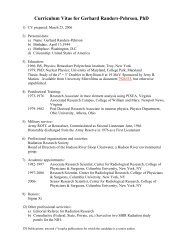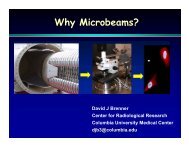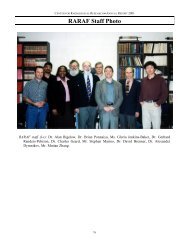LASER ION SOURCE DEVELOPMENT FOR THE - raraf
LASER ION SOURCE DEVELOPMENT FOR THE - raraf
LASER ION SOURCE DEVELOPMENT FOR THE - raraf
You also want an ePaper? Increase the reach of your titles
YUMPU automatically turns print PDFs into web optimized ePapers that Google loves.
CENTER <strong>FOR</strong> RADIOLOGICAL RESEARCH • ANNUAL REPORT 2004<br />
coincidence with pulses produced by the neutrons in the<br />
xenon detector. Since the initial neutron energy is known,<br />
the energy imparted to the xenon nucleus can be calculated.<br />
This energy divided by the height of the xenon detector<br />
pulse provides the calibration of the detector.<br />
Masao Suzuki of the National Institute of Radiological<br />
Science, Japan, in collaboration with Hongning Zhou of the<br />
CRR, continued his efforts to determine whether alphaparticle<br />
irradiation can induce a bystander response in primary<br />
human bronchial epithelial (NHBE) cells (Exp. 125),<br />
extending the study to bystanders of cytoplasmic irradiation.<br />
Either all or ten percent of the cells were irradiated in the<br />
cytoplasm with helium ions using the microbeam facility.<br />
The cells were then accumulated in the G2 phase of the cell<br />
cycle and the process of premature chromosome condensation<br />
(G2PCC) was used to observe chromatin aberrations.<br />
Preliminary data show cytoplasmic alpha-particle irradiation<br />
can induce a bystander effect. However, more irradiated<br />
cells as well as non-irradiated bystander cells are needed to<br />
further confirm the results.<br />
The occurrence of non-targeted effects calls into question<br />
the use of simple linear extrapolations of cancer risk to low<br />
doses from data taken at higher doses. Olga Sedelnikova of<br />
the NIH, in collaboration with Lubomir Smilenov of the<br />
CRR, is investigating a model for bystander effects that<br />
would be potentially applicable to radiation risk estimation<br />
(Exp. 126). They are evaluating the lesions that are introduced<br />
into DNA by alpha-particles and the resulting nontargeted<br />
bystander effect. These lesions, and particularly the<br />
most dangerous – double strand breaks (DSB), can be revealed<br />
by phosphorylation of the histone H2AX. Primary<br />
WI38 human epithelial cells stained with Hoechst dye that is<br />
visible to the microbeam imaging system are mixed with<br />
others stained with cyto-orange (bystanders) that are not<br />
visible. The cells dyed with the Hoechst stain are irradiated<br />
with graded numbers of alpha-particles. The numbers of<br />
DSB in directly irradiated cells and in non-hit cells in close<br />
proximity to an irradiated cell are estimated by phosphorylation<br />
of the histone H2AX. The results from these experiments<br />
as well as from experiments from other labs will be<br />
used to make an overall best assessment of the public health<br />
significance of bystander-mediated responses.<br />
William Morgan of the University of Maryland, in collaboration<br />
with Stephen Mitchell of the CRR, performed an<br />
investigation of the bystander effect (Exp. 129) using the<br />
GM10115 cell line which does not show gap junction communication.<br />
Cells were irradiated with 2 to 12 helium ions<br />
using the microbeam facility or were plated on the “strip”<br />
dishes described in Exp. 73 and given a dose of 5 Gy of helium<br />
ions using the track segment facility. No difference was<br />
seen for cell killing, emphasizing the importance of gap<br />
junctions in mediating the bystander response.<br />
Development of Facilities<br />
Our development effort has somewhat decreased this<br />
year from last but is still very high. We have added another<br />
person to the development team: Giuseppe Schettino, who<br />
developed the x-ray microbeam for the Gray Cancer Institute.<br />
70<br />
Development continued or was initiated on the microbeam<br />
facilities and a number of extensions of their capabilities:<br />
• Development of focused accelerator microbeams<br />
• Source-based microbeam<br />
• Focused x-ray microbeam<br />
• Precision z-motion stage<br />
• Laser ion source<br />
• Secondary emission ion microscope (SEIM) for viewing<br />
focused beam spots<br />
• Non-scattering particle detector<br />
• Advanced imaging systems<br />
• New accelerator<br />
Development of focused accelerator microbeams<br />
A quadruplet lens with titanium-coated rods was<br />
mounted in the alignment tube for the double lens system<br />
and placed in the beam line for the new microbeam facility.<br />
It focused the beam to less than a 7 µm diameter. Measurements<br />
made of the voltages required to obtain various beam<br />
spot geometries when all and only some of the lens elements<br />
were used provided data for our consultant at the University<br />
of Louisiana, Alexander Dymnikov, to calculate parameters<br />
for the double quadrupole triplet lens assembly that will be<br />
used to focus the ion beam to a diameter of 0.5 µm.<br />
The first quadrupole triplet based on these calculations<br />
has been constructed, placed in a separate alignment tube<br />
and inserted in the beam line in place of the quadruplet lens.<br />
This triplet lens has produced a beam spot for helium ions<br />
3.5 µm in diameter. It required very little voltage conditioning,<br />
produced an acceptable beam in less than a week of<br />
adjustments and has been used for microbeam irradiations<br />
for several months. The second quadrupole triplet is under<br />
construction in our shop and will be inserted for testing in<br />
place of the present one, once it is completed. When the<br />
voltages on this second lens have been adjusted to produce<br />
the smallest beam spot attainable, the two lenses will be<br />
mounted in a single tube for testing of the compound lens<br />
system that will produce a sub-micron beam spot.<br />
Source-based microbeam<br />
A stand-alone microbeam (SAM) has been designed<br />
based on a small, relatively low activity radioactive alphaparticle<br />
emitter (5 mCi 210 Po) plated on the tip of a 1-mm<br />
diameter wire. Alpha-particles emitted from the source will<br />
be focused into a spot 10 µm in diameter using a compound<br />
quadrupole lens made from commercially available permanent<br />
magnets, since only a single type and energy of particle<br />
will be focused. The pair of quadrupole triplets is similar to<br />
the one designed for the sub-micron microbeam, the only<br />
difference being that it uses magnetic lenses, rather than<br />
electrostatic lenses. A small stepping motor rotating a disc<br />
with holes will be placed just above the source to chop the<br />
beam, enabling single particle irradiations. The end station<br />
for the original microbeam will be used to perform microbeam<br />
irradiations. The SAM will replace the acceleratorbased<br />
system in our original microbeam laboratory and can<br />
be used during the period when the Van de Graaff is being<br />
removed and the Singletron installed.







